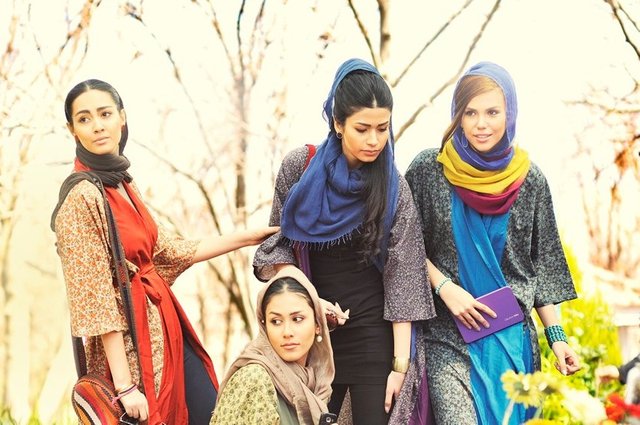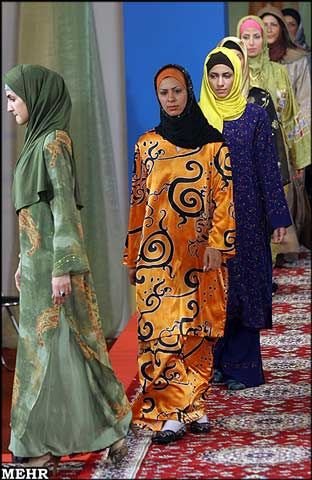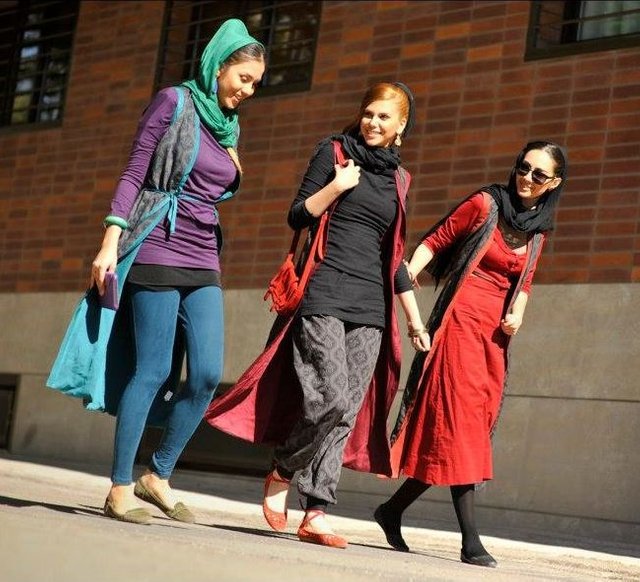The danger of fashion in Iran: Secret fashion shows that resist the «chador»
If you watch life in Iran on television, you will see only women walking in the streets in broad black clothes, and men in simple clothes that are not fashion-related, but the reality in Tehran is different from what you see on television. If you stroll through its streets, you will find it filled with boutiques selling the latest international brands, along with modern local designs, and you will see its residents keen to choose fashion that matches fashion lines.
trickery On restrictions:
Since the Islamic revolution in Iran, women have been forced to wear veils and chadors, a very large cloak that covers women from head to toe in black. Men also have a share of these restrictions.
Economic sanctions, while banning the import of clothing from abroad, have led to the emergence of Iranian fashion designers, who are creating modern designs that conform to the Iranian style.
At the beginning of the 1990s, women began to wear other colors of mantu, a summer version of which appeared with a rather short sleeves and a pair of jeans. The decline continued to increase until the shawl became a small cloth, and the wear of the chador became limited to women in conservative and rural cities.
With the imposition of economic sanctions on Iran, while banning the import of clothing from abroad, Iranian fashion designers, trying to design more modern-style clothing that conformed to the Iranian style, began to design the "Farnaz Abdoli" who tried to get Iranian women out of the chador and mantu, New as 'Bush Ma'
With the imposition of economic sanctions on Iran, while banning the import of clothing from abroad, Iranian fashion designers, trying to design more modern-style clothing that conformed to the Iranian style, began to design the "Farnaz Abdoli" who tried to get Iranian women out of the chador and mantu, New as 'Bush Ma'
The colored clothing is an external plot

"It is wrong to think that Iran is free of a great world of fashion and continuous fashion shows, but they are all hidden underground."
Abdoulaye, one of the most important designers in Iran, started her work in 2012 and says in a press interview with an Iranian magazine that she sees the chador and dark colors worn by Iranian women as very depressing. She decided to make clothes in bright colors of light fabrics that show the beauty of the woman's body. She hid her behind yards of bleak fabrics, while maintaining that fit the Iranian tradition. Abdoulaye began publishing her designs on instagram, but was met with fear by some of her followers. Abdoulaye did not give up, and decided to discuss with them, trying to convince them that some designs fit the streets and work, and even markets, and that was the reason for the popularity of their designs, as well as reasonable prices.
"These colorful costumes and light fabrics are only an external conspiracy to strike at Iranian customs and traditions." According to Abdoulaye, these were the charges against hardline clerics who do not see the chador as an alternative to women, although she sees her clothes fit Iranian society.
A world of fashion but underground

It is wrong to think that Iran is free of a great world of fashion and continuous fashion shows, but they are all hidden underground and that fashion designers have been in Iran for several years. Some have traveled to study in Europe and Iranian fashion designers began to publish their designs on social networking sites and use professional models to promote clothes. The Iranian regime realized that this would be out of control and resorted to the Islamization of fashion and fashion shows. The state assigned that task to the Ministry of Culture and Islamic Guidance, which in turn imposed a list of restrictions and laws on fashion shows, agencies and even exhibitors and exhibitors.
An Iranian woman presented her papers to the fashion business. She was examined medically to make sure she did not perform any cosmetic surgery, besides checking her criminal record and checking the drugs.
The Ministry of Culture and Islamic Guidance began organizing Islamic fashion shows, and it was called "Chastity and Hijab" under several restrictions and laws. And that one of the designers who has passed the tests by the ministry, said at the outset, we must submit designs for the ministry to be approved, and make sure that they are in accordance with the traditions of the Islamic Republic, and then comes to examine the models and exhibitors and inquire about them.an is thirsty for more innovation in clothes. One day, fashion in Iran will become the focus of everyone abroad.
But they are still a long way off. They are still buying under the ground. They do fashion shows on a weekly basis, but they are out of the limelight, which is humiliating, but they have no alternative solutions but to submit to the regime's restrictions and to join the Islamic fashion shows organized by the state.
From fighting fashion to monopoly

Iranian fashion designers began to publish their designs on social networking sites and use professional models to promote clothes. The Iranian regime realized that this would be out of control and resorted to the Islamization of fashion and fashion shows. The state assigned that task to the Ministry of Culture and Islamic Guidance, which in turn imposed a list of restrictions and laws on fashion shows, agencies and even exhibitors and exhibitors.
An Iranian woman presented her papers to the fashion business. She was examined medically to make sure she did not perform any cosmetic surgery, besides checking her criminal record and checking the drugs.
The Ministry of Culture and Islamic Guidance began organizing Islamic fashion shows, and it was called "Chastity and Hijab" under several restrictions and laws. And that one of the designers who has passed the tests by the ministry, said at the outset, we must submit designs for the ministry to be approved, and make sure that they are in accordance with the traditions of the Islamic Republic, and then comes to examine the models and exhibitors and inquire about them.
We contacted one of the models who successfully passed the ministry's tests but refused to disclose her name. She told us that choosing an Iranian woman to show her a career was very complex. She started out in this field through fashion shows in the houses, but she wanted to practice the profession officially, and with the permission of the state because she wanted to see the fashion agencies of the world, and submitted her papers to the ministry and was examined medically to make sure that she did not perform any cosmetic, One of the ministry's requirements, along with several tests of its criminal records, drugs and, unexpectedly, in fashion and fashion shows, was its length and weight.
This model has succeeded in all tests, and has been taught by the Iranian-style fashion show. The models are walking militarily, contrary to the way models run around the world, and it is forbidden to smile or look at the audience. She is a leading figure in the Iranian fashion industry, and she is believed to have a close relationship with some officials in the Iranian government.
In 2015, after all attempts by Iranian fashion designers to come to light, Iran held its first week of fashion, but was organized under the auspices of the Ministry of Culture and Islamic Guidance. Although the week was surrounded by regime restrictions and did not satisfy the thirst of fashion makers, they saw it as a rather positive step.
Ripped Jeans and Ligans are a threat to Iran's security
Iranians began to experiment with new styles of clothing instead of chadors and mantos, relying on the fashion revolution of Iranian fashion designers and the entry of clothes from Turkey to Iran. The change that has long plagued the Iranian regime and clergy began. In the event.
In 2014, the Iranian Parliament summoned the Minister of the Interior to question him in the Ministry's failure to prevent the deployment of the pants. His response was that the ministry was exerting every effort to confront this "danger".
Before the ripped jeans, the clergy fought a big battle against a new danger, and a plot from the West over Islamic culture; With the spread of modern designs in Iran, the Iranian women wore a rather short dresses instead of a wide petticoat, and pants had to be worn under them, so they went to the ligans. "Masumah," says she likes this type of pants because it is lighter and easier to move, and its price is cheap compared to jeans, for example.
In 2014, the Iranian Parliament summoned the Minister of the Interior to question him regarding the Ministry's failure to prevent the deployment of these trousers. He replied that the ministry is exerting every effort to confront this danger. He said that the ethics police regularly patrol the shops that sell these pants to confiscate them. Will the Iranian people and fashion makers succeed in their war to spread a new culture, under a regime that sees fashion as dangerous
Your Post Has Been Featured on @Resteemable!
Feature any Steemit post using resteemit.com!
How It Works:
1. Take Any Steemit URL
2. Erase
https://3. Type
reGet Featured Instantly – Featured Posts are voted every 2.4hrs
Join the Curation Team Here | Vote Resteemable for Witness